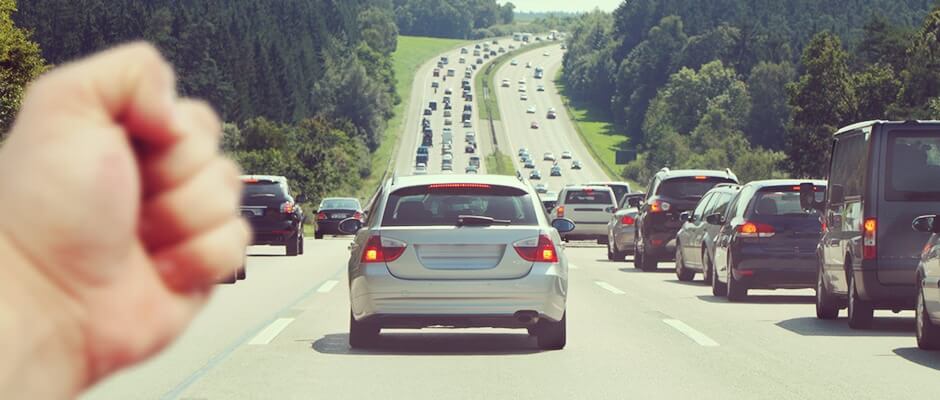Most of you will have experienced road rage from other drivers from time to time – it’s even more likely if you’re regularly driving in rush hour, when the roads are filled with drivers in a hurry travelling to or from work or school.
And sometimes it’s more than just a rude gesture out of a window – in 2012 there were 2,448 recorded accidents in the UK caused by “aggressive driving”.¹
Road rage towards learner drivers
It’s often the most vulnerable drivers who are the victims of road rage, with L-plates being a common trigger. Simon Douglas, Director of the AA Driving School says “An idiotic few see the L-plate as their own licence to harass learners with actions that are cowardly, bullying and sometimes downright dangerous.”²

The AA Driving School has even reported incidents where pedestrians have thrown stones, eggs and – shockingly – fireworks at learner drivers.³
New fixed penalty notices
The government has attempted to crack down on road rage and aggressive driving by changing the way certain motoring penalties work.
Police officers can now issue a £100 fine and give 3 points for⁴ :
- Tailgating
- Overtaking and pushing into a queue of traffic
- Pushing into a roundabout queue
- Failing to give way
- Lane hogging

Road rage: why do people do it?
Research suggests that aggressive driving is not just down to careless habits or a specific group of “problem drivers”.⁵ Studies have proven that drivers are able to “dehumanise” other motorists on the road, in the same way as they might behave online.⁶ This leads some motorists to behave in a way that they wouldn’t normally behave in their day-to-day life.
That being said, there seem to be certain personality traits that make particular drivers more prone to aggressive driving – for example, the personality traits known as “sensation-seeking” and “impulsiveness” rank highly as being present in road rage offenders.⁷
Research shows that we’ll often blame others’ personalities or abilities for driving errors, while blaming our own on the external environment or a situation out of our control.⁸ This may lead to anger and frustration being directed at other motorists.
Tips to help avoid being a victim of road rage
There are a few simple steps you can take on the road to try and make yourself less at risk of road rage from other drivers:
- Be considerate to other road users – try not to upset other drivers! The Highway Code has some helpful guidelines.
- Be patient, remember that everyone makes mistakes from time to time – remember the other driver may be inexperienced or could be driving on unfamiliar roads.
- Try and avoid conflict with other drivers – sometimes motorists will be looking for an argument. Focus on your driving and try not to make eye contact when waiting in traffic.⁹
- Make sure you’re fully concentrating when driving. Don’t allow yourself to be distracted by music, map reading or passengers in your car. Put your mobile phone somewhere out of sight so you’re not tempted to check it while driving.
- If you’re driving on the motorway or a dual carriageway, don’t be guilty of “lane-hogging”, as this is a common source of frustration for other drivers. Check out this video from the Highways Agency:
How to deal with road rage and aggression from other drivers
1. Try not to rise to it and act aggressively in response. If necessary, pull over where and when it’s safe to do so, take a deep breath and continue your journey once you’re feeling calm.¹⁰
2. If an aggressive driver is tailgating you, don’t sacrifice your own safety on the road by allowing yourself to be intimidated or break the speed limit. Try and make it safe for the tailgater to pass you – for example going round a roundabout twice might help.¹¹
3. Stay in control of your vehicle – do not respond by swerving or braking suddenly (unless it’s necessary to avoid an accident) as this could put you and other drivers in danger, and encourage the other driver to act more aggressively.¹²
4. If you’re being persistently harassed by the same aggressive driver, you may want to make your way to a safe, public place and call the police.¹³
The most important thing to remember is not to sacrifice your own safety when subject to road rage or aggression from other drivers. Stay calm, remain focused on the road ahead, and try to diffuse the situation whenever possible.
Dealing with stress while driving
If you’re exposed to aggression from other drivers it can be a very stressful experience. Safe driving requires a calm approach and full concentration, so here are a few tips to help deal with stress on the road:
- Take deep, controlled breaths to help relieve muscular tension¹⁴
- Take a break if you need to – don’t keep driving if you feel like it’s not safe
- Focus on the road – it sounds obvious but try not to go over the stressful incident in your head, just try to concentrate on the road and your safe driving.
Sources:
[1] https://www.gov.uk/government/uploads/system/uploads/attachment_data/
file/244137/ras50001.xls
[2] [3] http://www.theaa.com/motoring_advice/news/driving-school-road-rage-idiots.html
[4] http://www.bbc.co.uk/news/uk-23713732
[5] [6] [7] [8] http://www.theguardian.com/science/head-quarters/2013/aug/19/driving-road-neuroscience-psychology
[9] [11] [13] http://www.rospa.com/roadsafety/adviceandinformation/driving/road-rage.aspx
[10] https://www.gov.uk/general-rules-all-drivers-riders-103-to-158/general-advice-144-to-158
[12] http://www.chiltern.gov.uk/article/1733/Road-Rage
[14] http://www.brake.org.uk/info-resources/info-research/road-safety-factsheets/15-facts-a-resources/facts/487-driver-stress
.
